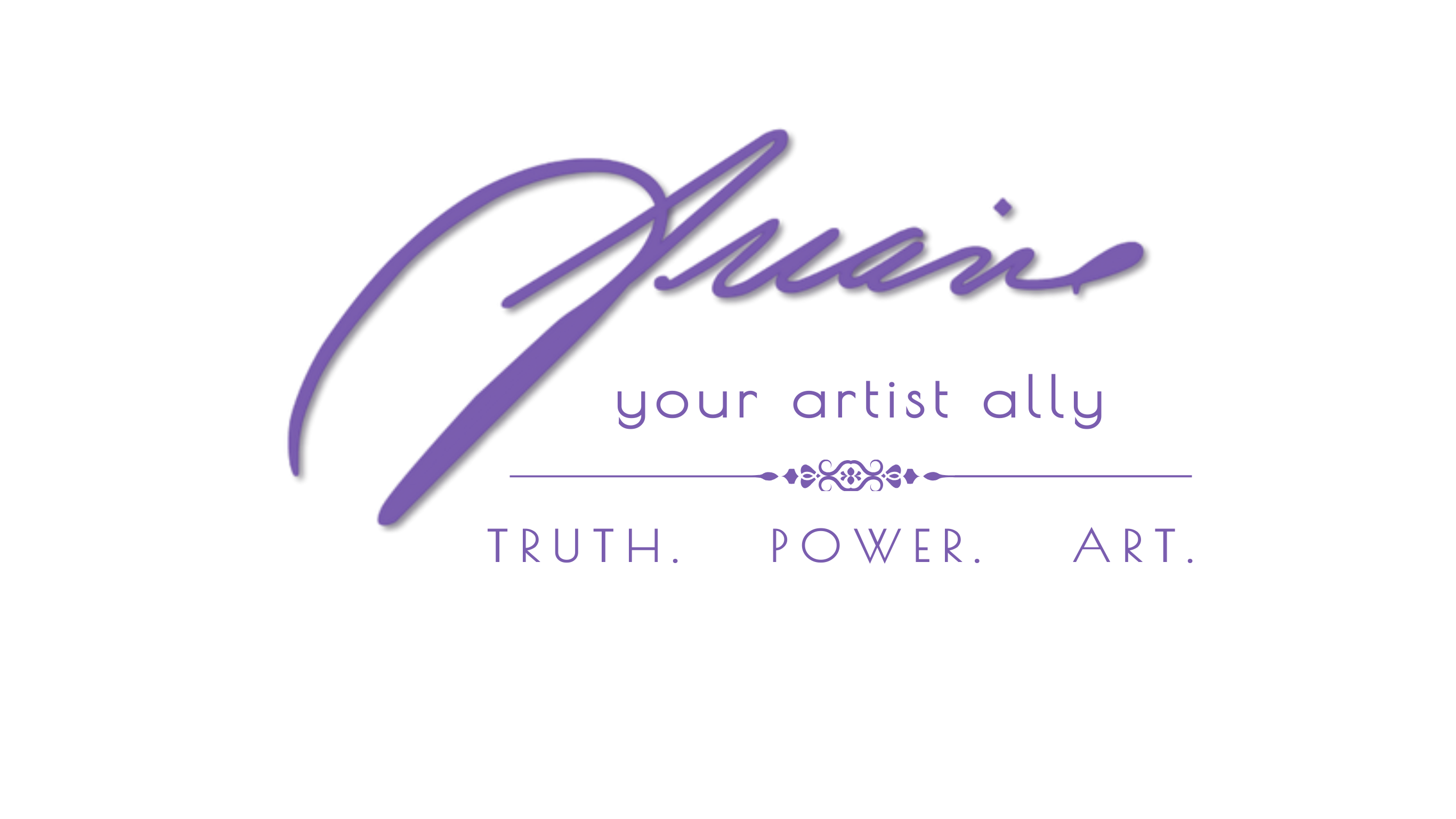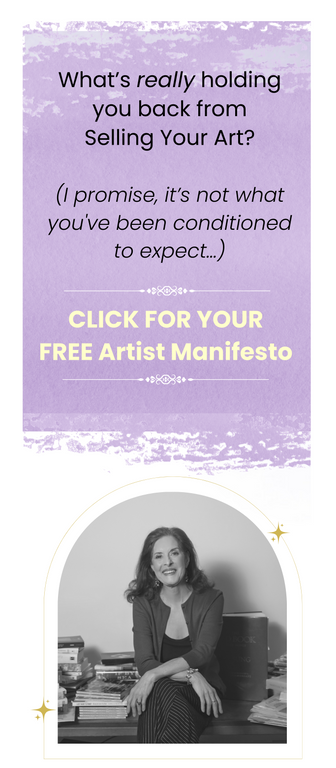I believe there is A Path of Visionary Affluence for every visual artist for selling your art. And it begins with the Three Gates of Relationship—which are intimately knowable, easily accessible, and practical to implement.
And when you align yourself with these relationship gates, it will impact your mindset for how you sell your art.
However, before we dive into the gates, there’s a question I want to ask you: What Is Art?
Ah, yes, the question asked down the ages.
With answers, as we all know, that range from the absurd to the sublime.
From Gauguin’s, “Art is either a plagiarist or a revolutionary.” To O’Keefe’s, “Art is not what you see, it’s what you make others see.”
I have a folder full of these quotations on art; each one as varied as the individuals speaking.
It’s as if each quote is one piece in a tapestry of how art impacts culture, along with the individuals in that culture. And each piece adds to the overall sense that above all, art is infinitely important to humanity no matter where or when.
Before we get to the Three Gates of Relationship (coming up…), giving yourself permission to answer “What Is Art?” will tell you what you value about art, and how you use what you value in both defining yourself, and in making your art.
It will guide you in understanding how to identify the Three Gates of Relationship for yourself.
Defining What Is Art? is not a small exercise. It’s essential.
Here, I’ll take a stab at it and then it’s your turn.
Ariane Answers: What is art?
At the physical level?
It’s an object you’ve created in time and space.
At the mental level?
It’s an idea that arose in the hallowed halls of your imagination.
At the emotional level?
It’s the fulsome expression of a feeling inside you that wants, or needs, manifestation in time and space.
At the intuitive level?
It’s one more demonstration of what ignites your creative spirit.
At the spirit level?
It’s one more, infinite outcome of What Is.
At the personal level?
It’s what connects you to others. It’s the emotional, highly personal container in which you live that encourages an engagement with others that you might not even be aware of craving.
At the art-career level?
It’s the collector/buyers that come (or don’t) to your door.
It’s the offering you proffer to the collectors/buyers who want your art.
But none of my responses matter if you are not aware of what art is for you!
I know, this feels a bit esoteric, and you want to sell your art.
I get it. I truly do.
But since selling your art is directly connected to another person—your buyer/collector— understanding how your buyer/collector is connected to you through your art becomes the doorway that opens more sales.
And how can you do that?
You start by looking at the Three Gates of Relationship in the same way you study a piece of art you are making: look directly at what you actually see, not what you think you see.
The Three Gates Of Relationship That Most Impact Selling Your Art
GATE ONE:
Your relationship to yourself as an artist: aka, your artist identity
How well do you actually know yourself, as an artist?
Have you ever examined the qualities of your Artist Self vs the qualities of your Family Self vs the qualities of your Friend Self?
Have you ever taken the time to identify and name these Artist Self qualities?
Or how these integrate into the art you make? How they impact the way you communicate with the world about your art?
How they impact selling your art?
Have you ever taken the time to connect the dots between who you are, what you make, and how you offer this to your potential buyers?
Or have you settled for an artist identity that remains at the subconscious level, where, because there is no shining light of conscious awareness, it remains relatively in the dark, relatively unknown?
And quite literally use-less… because you can’t use what you can’t name.
Since word language is so fundamental to how humans experience every aspect of our lives, when a “thing” goes unnamed, it actually goes unknown. In a very literal sense, it doesn’t exist.
When you can’t name something, when it remains an inchoate experience, you have no way to use it for further growth.
When your Artist Identity remains unknown, in a very literal, word-language sense, it keeps you from leaping forward with clarity and, yes, joy.
It also keeps you from a powerful truth that could help you sell your art more easily because sharing a deep truth that is connected to your art is essential in nudging your potential buyers/collectors toward wanting to buy—so you don’t have to push a sale.
When you identify, name, and wholly own exactly who you are as an artist, you ignite core aspects of yourself that have always been a part of you, have always existed to help you transcend any art-world challenge.
When you expand your awareness of your artist identity, it no longer languishes half-in and half-out, but steps fully elevated into your ArtLife.
GATE TWO:
Your relationship to your art: aka, your artistic fingerprint connection
As I outlined in another blog post, here’s my definition of an artistic fingerprint:
First, it’s not your artistic voice (unless you’re planning an Off Broadway review).
It’s not your artistic style (unless you’re planning a runway collaboration during Fashion Week. Or you want to know where your work is on the historical art styles spectrum).
You Artistic Fingerprint is what distinguishes you from the thousands of other artists all vying for visibility.
It is what sets you apart from the pack of ordinary work, where a dozen pair portraits from a dozen different artists could be lined up next to each other and all look as if they came from the same artist.
It’s the X factor in every, single piece you create that tells anyone that you, and you alone, made this.
And like your literal fingerprint, no one else can truly duplicate what you do.
When your work is speaking from the level of your soul, no one can ever successfully copy you. Your artistic fingerprint is just that: yours. By definition it cannot be anyone else’s.
Only a lot of artists feel confused by the difference between loving what they have just made, and knowing the work carries a distinct sense of who they are as an artist.
GATE THREE:
Your relationship to the people who want your art: your artist statement
At the heart of an artist statement is this:
Reaching to understand what, how and why you do what you do does not dismantle either the beauty or mystery of it. Quite the opposite. Revealing the evolution of your understanding invites others to participate in the mystery and to share the beauty. ~Ariane
When you give the art buyers/collectors a peek behind the canvass, and create meaningful connections with you and your work, you are letting them know that it’s okay to truly see you. And truly seeing each other engenders a deep connection between seer and seen.
The artist statement, when it reveals your relationship to your work, becomes an invitation to step into your inner world as it spills out from your soul into their world.
Like the art which it reflects, an artist statement uses its sincerity of purpose and its purity of intent to create a powerful word-reflection of the art and the artist.
The point of an artist statement is to be in service to your art, not the marketplace.
Labeling an artist statement as something primarily for marketing diminishes the spirit behind your work. Like art created with the pocketbook in mind, artist statements which focus on the shallow “point of purchase” technique lose their authenticity, their authorship and their unique reflections by artists about their work.
The relationship you have with your artistic fingerprint is the most important thing humming beneath the words of your artist statement. This relationship of Gate Two affects what you write, and frames your writing tone of voice for the statement.
If you connect to the spirit inherent in your relationship to your artistic fingerprint, the words you use in your artist statement will sing at your next opening.

Gate One & Two Overlap:
I know who I am as an artist, I know my artistic fingerprint. However, even though I am producing my best work, it’s not selling at the level I want, or sales are inconsistent because I’m in my own bubble of “self” and “art.”
Gate One & Three Overlap:
I know who I am as an artist and I’m invested in the buyers/collectors who want my art. However, by not fully understanding and communicating my artistic fingerprint, I’m don’t have the leverage to maximize their loyalty.
Gate Two & Three Overlap:
I know and communicate my artistic fingerprint to my viewers, whom I court on a regular basis. But since I don’t know enough about my purpose and presence as an artist, my artist identity as it flows from my soul, my vulnerability and creative expression are limited.
=========================================
With the right support, all three of these Gates of Relationship weave together an art career where selling your art—with the creative mindset that each of these Gates are intimately knowable, easily accessible, and practical to implement—can bring you the same level of exhilaration and satisfaction you get from creating your art.








